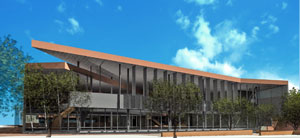Sustainability
Expanded University of Arizona rec center pursuing a LEED Silver certification
Planned sustainable design principles will likely result in the university's first LEED-certified building
By Colleen Morgan, Facilities Project Manager, The University of Arizona Department of Facilities Design and Construction
 |
|
The architect's computer-generated rendering of the north side of The University of Arizona's expanded Student Recreation Center.
|
Students at The University of Arizona are investing in their health and the environment through the construction of a tremendous expansion to an almost two-decade-old, overcrowded recreation center. The Student Recreation Center Expansion project at The University of Arizona is committed to sustainable design principles in every aspect of the project's design and construction. The project is currently registered with the US Green Building Council and will be the first University of Arizona building to pursue a Leadership in Energy and Environmental Design (LEED) Silver Certification.
The project team of architects (Sasaki/M3), engineers, contractors, and Department of Campus Recreation staff and students have been working on the building planning for more than a year and are getting ready to put those plans into action. At more than 58,000 gross square feet, the new expansion is comprised of four major spaces: a Fitness Room, a Multiple Athletic Court (MAC) Gymnasium, an Outdoor Adventures program, and an exterior courtyard (including bouldering and sand volleyball courts). Construction is scheduled to begin in late 2007 and is expected to last approximately eighteen months.
The use of daylight is fundamental to the expansion's character and greatly enhances the student experience. The three major interior spaces are oriented to capitalize on the introduction of light from the north and south, the most controllable sun exposures. Large expanses of low emissivity glass allow views from, and natural light into, every occupied space while maintaining an efficient building envelope. The building has solid walls on the east and west and deep roof overhangs to avoid introducing direct sunlight into the building, which is essential to minimizing thermal gain and controlling glare.
Natural light is dramatically introduced to the Fitness Room through a "fracture" of the roof plane, bringing daylight through clerestory windows at the ceiling of this large, two story space. A translucent wall on the north side of the Multiple Activity Court provides a constant and even lighting level for gym activities. The Outdoor Adventures program is being relocated to a prominent location off the courtyard, providing a strong indoor/outdoor relationship that will showcase Outdoor Adventures' offerings and an abundance of natural light. In all these areas of the building, multi-level, daylight-sensing lighting controls reduce electric lighting use during daylight hours.
Care has been taken to choose materials that mitigate the project's impact on natural resources. Local manufacturers are being specified as sources for concrete and concrete masonry (two of the building's main components), thereby reducing material transportation requirements. Many other building materials were selected due to their high percentage of recycled content: rubber sports flooring, carpet in offices, structural steel frame, and site and structural concrete. Where wood is being used (in doors and the gymnasium flooring), it's required to be certified by the Forest Stewardship Council for sustainable forestry practices.
The construction process is also being managed in a more sustainable fashion. Diverting more than 75% of construction wastes from landfills by segregating recyclables is a goal of the project. The parking lot surface - one of the most voluminous waste components - will be pulverized and incorporated into the structural soil under the building's foundations.
Water harvesting principles are evident in the site design, an important feature in a region that only receives about twelve inches of rainfall a year. Permeable surfaces in the courtyard serve as both passive/active recreation areas and rainwater infiltration basins. Rainwater runoff from an adjacent parking area is captured and diverted from contributing to storm water on surface streets around the site. Swales and microbasins are incorporated throughout the site to slow runoff and allow percolation so the landscape can take maximum advantage of even small amounts of rain.
The plant palette is comprised of Sonoran Desert natives and drought tolerant species: blue palo verde, sweet acacia, and ironwood trees, fairy duster and desert spoon shrubs, and succulent varieties such as agave and yucca. Trees in the Outdoor Adventures courtyard produce fruit that will be used in meals prepared for multi-day trips.
Students have played a major role in the development and design of the expansion project and are the key stakeholders in that the project is entirely student funded. Without their leadership and contributions - and support of the project's sustainable goals - this expansion of the Student Recreation Center would not be possible.
What does your campus recreation department do to promote sustainability? Email Katherine Otten your best green practices, and look for highlights in future issues of the NIRSA Know.
|

